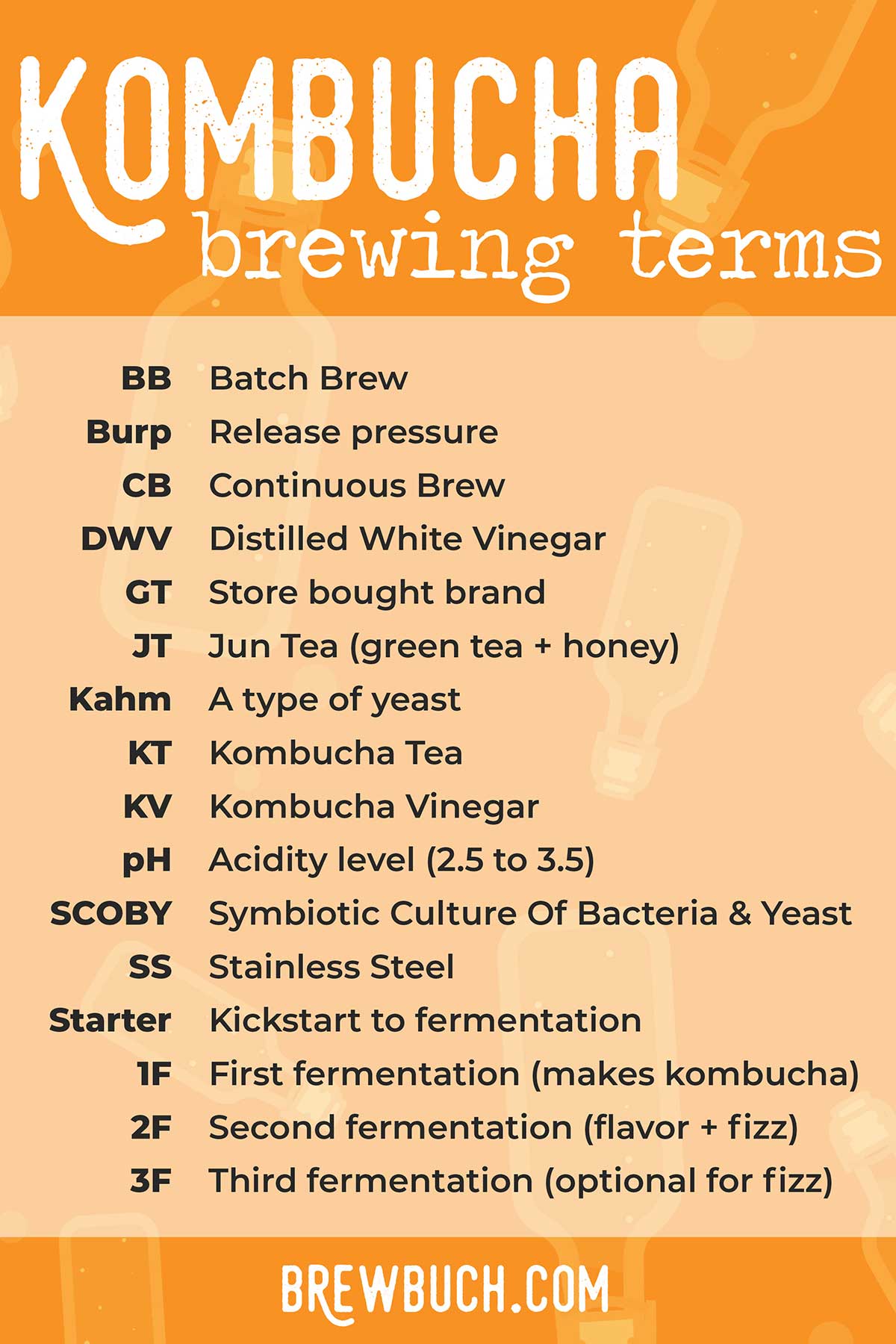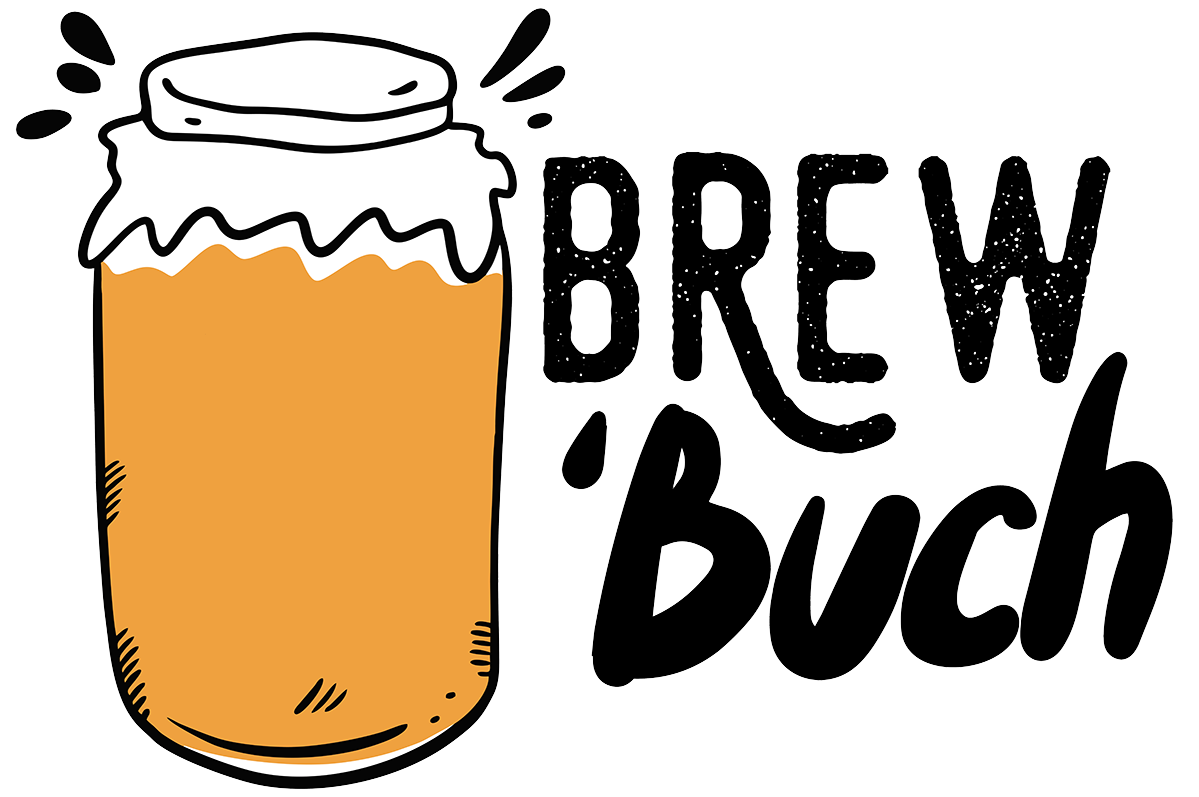Confused by the terminology when it comes to home brewing? Here’s our glossary of all things kombucha, including common acronyms and terms.

Batch Brew (BB)
A method of brewing kombucha where the entire batch is harvested when it’s finished fermenting. Learn more about batch brew here.
Burping
Opening the lid or cap of bottles during the second fermentation to release pressure build up, thereby preventing explosions.
Carbonation
Forcing the carbon dioxide produced by the yeast to remain in the kombucha, producing a fizzy, effervescent feeling. This typically happens in the second of third fermentation. More on kombucha carbonation here.
Continuous Brew (CB)
A method of brewing kombucha where some of the tea is harvested, then more sweet tea is added to replace it, creating a continuous cycle of kombucha brewing. Learn more about continuous brew here.
Decant
Transferring finished first fermentation kombucha to bottles.
Distilled White Vinegar (DWV)
An acidic vinegar used for cleaning kombucha supplies.
GT
A brand of store bought kombucha. We love using GT’s Original Unflavored Kombucha to act as the starter for growing a SCOBY.
Jun Tea (JT)
Similar to kombucha, but with green tea and raw honey.
Kahm Yeast
A type of yeast that can sometimes grow in kombucha. While it is not desired, it doesn’t require you to throw out the whole batch (like the presence of mold would). Kahm yeast is usually a white filmy layer that can occur in over fermented kombucha.
Kombucha Mother
Another name for the kombucha SCOBY, which is the starter (or mother!) of the fermentation reaction.
Kombucha Mushroom
Another name for the kombucha SCOBY, because it is a living colony of bacteria and yeasts.
Kombucha Tea (KT)
Plain and simple kombucha tea that has undergone the first fermentation.
Kombucha Vinegar (KV)
Accidentally let your kombucha brew too long? You probably have kombucha vinegar! This is more acidic and sour, but can be used like most other vinegars (for instance, in cleaning, cooking, or vinaigrettes).
Ooglies
The *highly technical* name for the brown stringy pieces of yeast that may develop on the bottom of your kombucha SCOBY. These are natural in the fermentation, but should be removed once your SCOBY becomes larger in order to keep the balance of bacteria and yeast in harmony.
pH
An expression of acidity, with a lower pH indicating a more acidic liquid. Most kombucha has a pH between 2.5 and 3.5. For reference, lemon juice has a pH of 2, and water has a pH of 7. Test your kombucha pH with this tool.
SCOBY Hotel
A place to store your unused SCOBYs for when you’re not actively using them. It’s simply a clean jar filled with kombucha that you can plop your SCOBY. They can be stored for a few months before needing some maintenance (adding food, removing excess yeast, checking for mold).
Stainless Steel (SS)
While you should avoid prolonged contact with most metals, 304 stainless steel is the one metal that can come into contact with your brew (such as a stainless steel vessel or spigot).
Starter Tea
Starter tea is simply already-made kombucha that you add to sweet tea in order to kick off the process of fermentation. It has all the bacteria and yeast needed for fermentation to occur.
SCOBY
A Symbiotic Culture/Colony Of Bacteria and Yeast. There is divide in the brewing world as to what exactly the SCOBY is. Many say that the pellicle (cellulose pancake on top of the brew) is the SCOBY, while others say that the starter tea is the SCOBY. For the purposes of this website, the pellicle on top will be called the SCOBY, as it’s what most people are accustomed to! Learn more about the SCOBY here.
Vessel
The jar or container you brew your kombucha in.
Vinegar Eels
Non-harmful microscopic nematodes that can infiltrate your kombucha if you cleaned with or added raw vinegar to your brew. These can harm your kombucha in the long run and should be prevented.
1F
The first fermentation. This is where you actually make the kombucha that you’ll be drinking. It usually takes 6 to 10 days (up to 30 days). Learn how to brew the first fermentation here.
2F
The second fermentation. This is where the real magic happens, flavoring and carbonating your kombucha into effervescent bliss. It is an optional step that usually takes 3 to 10 days. Learn how to brew the second fermentation here.
3F
The third fermentation. This is an optional different method for carbonating kombucha. With this method, you flavor the kombucha in 2F but don’t seal it shut. Then strain out the fibers and bottle, sealing shut for a 3F where the flavored kombucha is carbonated. (We typically stick to the 2F here on Brew Buch).


What is the method for carbonating?? I’ve done f1, flavored in sealed bottles in f2, but when I strain the fruit and put into refrigerator bottles, it loses carbonation. I’ve recently read about f3 but am not sure of the process. How does f3 differ from f2?
I typically strain right before serving to help prevent this loss of carbonation! But you could do an F3, which would just be straining the fruit then letting the sealed bottled sit at room temp until re-carbonated 😀
I have a vessel that I would like to use for continuous brewing. It is a glass vessel with a spigot. The spigot has a small amount of plastic inside vessel that would come in contact with the brew. I have heard that plastic is BAD. Will that amount of plastic (about an inch diameter) hurt the brew?
Thank you for your great site!
Plastic is usually not used because it is porous and can house nasty bacteria. If you make a point of keeping it clean (like submerging in boiling water every few batches and swishing with vinegar), I think it would be okay.
Hi, I know I’m not on the right article to ask this question but can i use white Vinegar instead of distilled?
For cleaning? Yes. Just as long as you don’t use any raw vinegars!
how do you tell the difference between “Ooglies” and “Vinegar Eels”?
Is there a picture?
Do they occur at different fermentation times?
Ooglies are just brown stringy things that are very normal in fermentation. Vinegar eels are not common and you will hopefully never see one. They’re a worm like creature that lives in the buch!